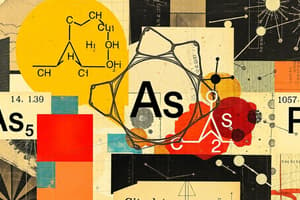Podcast
Questions and Answers
What is the charge of a neutron?
What is the charge of a neutron?
- Neutral (correct)
- Negative
- Positive
- Opposite of a proton
Which particles are found in the nucleus of an atom?
Which particles are found in the nucleus of an atom?
- Protons (correct)
- Neutrons
- Electrons
- Isotopes
What are electrons responsible for in an atom?
What are electrons responsible for in an atom?
- Providing stability to the compound
- Giving the nucleus a positive charge
- Determining the chemical properties (correct)
- Determining the shape of the molecule
Which particles move around the nucleus in electron orbitals?
Which particles move around the nucleus in electron orbitals?
Alpha particles consist of how many protons and neutrons?
Alpha particles consist of how many protons and neutrons?
What determines the shape of a molecule?
What determines the shape of a molecule?
In an ionic bond, what happens when a metal atom loses an electron?
In an ionic bond, what happens when a metal atom loses an electron?
Which type of bonds result from the sharing of electrons to satisfy the octet rule in both atoms?
Which type of bonds result from the sharing of electrons to satisfy the octet rule in both atoms?
Which type of compound contains single bonds between carbon atoms, making them unreactive?
Which type of compound contains single bonds between carbon atoms, making them unreactive?
What functional group characterizes alcohols?
What functional group characterizes alcohols?
What is the general formula for hydroperoxides?
What is the general formula for hydroperoxides?
Which type of organic compound contains a carboxyl group and an alkyl or aryl group?
Which type of organic compound contains a carboxyl group and an alkyl or aryl group?
Flashcards are hidden until you start studying
Study Notes
Chemistry A-Level
The A-level in Chemistry is a two-year advanced level course designed to prepare students for higher education or employment in fields related to science. This program focuses on several areas of study, including atomic structure and organic chemistry.
Atomic Structure
Atomic structure refers to the arrangement of protons, neutrons, and electrons within the nucleus and electron shells of atoms. In this section, we will discuss various aspects of atomic structure relevant to the A-Level Chemistry curriculum:
Protons, Neutrons, and Electrons
Protons and Neutrons
Protons and neutrons are found in the nucleus of an atom. Protons are positively charged particles due to their positive charge, while neutrons have no charge (they are neutral) because they do not carry any electric charge.
Electrons
Electrons surround the nucleus of an atom and are responsible for its chemical properties. They are negatively charged particles and move around the nucleus in shells called electron orbitals.
Nuclei and Isotopes
Nuclear reactions typically involve either alpha particles or beta particles. Alpha particles consist of 2 protons and 2 neutrons, while beta particles can be either beta+ particles (which are actually electrons) or beta- particles (which are actually positrons).
Electron Configuration and Bonding
Electron configuration determines the shape of a molecule. It also helps predict which elements form stable compounds with which other elements. For example, it explains why group 17 halogens readily combine to form diatomic anions like Cl2-, Br2-, I2-, and F2-, whereas the next members of Group 18 noble gases (He, Ne, Ar, Kr, Xe, Rn, O, and N) do not form such species.
Ionic Bonds
Ionic bonds occur when valence electrons are transferred between metal and nonmetal atoms. When a metal loses an electron, it becomes positively charged and attracts an electron from a nonmetal's outermost energy level, resulting in negative ion formation. These oppositely charged species are attracted to each other by electrostatic forces, forming an ionic compound.
Covalent Bonds
In a covalent bond, the sharing of electrons contributes to both atoms obtaining a full octet of electrons in their outer energy levels, thus satisfying the octet rule.
Organic Chemistry
Organic chemistry is a branch of chemistry that deals with carbon-based compounds. Specifically, it explores the synthesis, analysis, reactivity, and properties of organic compounds to understand the underlying principles of living organisms. Some key concepts covered under organic chemistry during the A-Level Chemistry curriculum include:
Alkanes
Alkanes are saturated hydrocarbons composed entirely of carbon and hydrogen atoms. They are characterized by single bonds between carbon atoms, making them more unreactive compared to unsaturated hydrocarbons.
Alkenes
Alkenes contain one less hydrogen atom per carbon atom relative to alkanes. They possess a double bond between carbon atoms, which makes them more reactive than alkanes.
Alcohols
An alcohol consists of a hydroxyl group attached to a carbon atom through a covalent bond. The most common type of alcohol is ethanol (CH3-CH2-OH), which is used as a solvent and as fuel in many industries.
Hydroperoxides
A hydroperoxide has the general formula ROOH, where R represents an alkyl group. It contains a peroxide linkage between an oxygen atom and another element, usually a hydrogen atom.
Carboxylic Acids
Carboxylic acids are organic compounds containing both a carboxyl group (-COOH) and an alkyl or aryl group (-R).
Aromatic Compounds
Aromatic compounds have a unique, stable electron configuration. They contain pi bonds between the carbon atoms, making them highly stable and resistant to chemical reactions.
The A-Level Chemistry course covers these topics in depth, providing a comprehensive understanding of the principles and applications of atomic structure and organic chemistry.
Studying That Suits You
Use AI to generate personalized quizzes and flashcards to suit your learning preferences.




